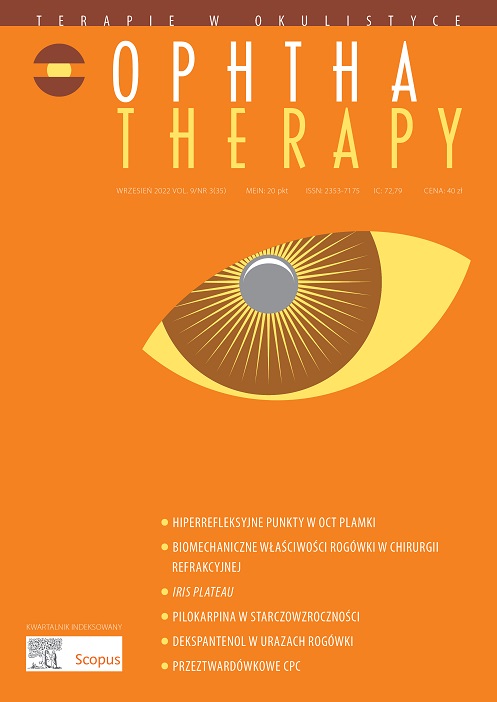The role of corneal biomechanical properties assessment in laser vision correction – the introduction Artykuł przeglądowy
##plugins.themes.bootstrap3.article.main##
Abstrakt
The role of corneal biomechanical properties in patients referred to laser vision correction (LVC) is currently being raised. Understanding of corneal biomechanics may support the proper selection of refractive surgery candidates, improve the refractive outcomes and safety of refractive procedures. The Ocular Response Analyzer (ORA) and Corvis ST are commonly used devices to assess corneal biomechanical parameters in LVC. The vertical corneal incisions have a greater impact on corneal biomechanics weakening than horizontal incisions. Maintaining the high biomechanical strength of the cornea following LVC can decrease the potential risk of postoperative ectasia.
Pobrania
##plugins.themes.bootstrap3.article.details##
Copyright: © Medical Education sp. z o.o. License allowing third parties to copy and redistribute the material in any medium or format and to remix, transform, and build upon the material, provided the original work is properly cited and states its license.
Address reprint requests to: Medical Education, Marcin Kuźma (marcin.kuzma@mededu.pl)
Bibliografia
2. Damgaard IB, Re¬at M, Hjortdal J. Review of Corneal Biomechanical Properties Following LASIK and SMILE for Myopia and Myopic Astigmatism. Open Ophthalmol J. 2018; 12: 164-74. http://doi.org/10.2174/1874364101812010164 .
3. Shang J, Shen Y, Jhanji V et al. Comparison of Corneal Biomechanics in Post-SMILE, Post-LASEK, and Keratoconic Eyes. Front Med (Lausanne). 2021; 8: 695-97. http://doi.org/10.3389/fmed.2021.695697 .
4. Knox Cartwright NE, Tyrer JR, Jaycock PD et al. E¬ects of variation in depth and side cut angulations in LASIK and thin- ap LASIK using a femtosecond laser: a biomechanical study. J Refract Surg. 2012; 28(6): 419-25. http://doi.org/10.3928/1081597X-20120518-07 .
5. Xin Y, Lopes BT, Wang J et al. Biomechanical E¬ects of tPRK, FS-LASIK, and SMILE on the Cornea. Front Bioeng Biotechnol. 2022; 10: 834270. http://doi.org/10.3389/fbioe.2022.834270.
6. Huang G, Melki S. Small Incision Lenticule Extraction (SMILE): Myths and Realities. Semin Ophthalmol. 2021; 36(4): 140-8. http://doi.org/10.1080/08820538.2021.1887897.
7. Corneal Biomechanics. Measurement Parameters .
8. Zhao Y, Shen Y, Yan Z et al. Relationship Among Corneal Sti¬ness, Thickness, and Biomechanical Parameters Measured by Corvis ST, Pentacam and ORA in Keratoconus. Front Physiol. 2019; 10: 740. http://doi.org/10.3389/fphys.2019.00740.
9. Piñero DP, Alio JL, Barraquer RI et al. Corneal biomechanics, refraction, and corneal aberrometry in keratoconus: an integrated study. Invest Ophthalmol Vis Sci. 2010; 51(4): 1948-55. http://doi.org/10.1167/iovs.09-4177.
10. Cavas F, Piñero D, Velázquez JS et al. Relationship between Corneal Morphogeometrical Properties and Biomechanical Parameters Derived from Dynamic Bidirectional Air Applanation Measurement Procedure in Keratoconus. Diagnostics (Basel). 2020; 10(9): 640. http://doi.org/10.3390/diagnostics10090640.
11. Esporcatte LPG, Salomão MQ, Lopes BT et al. Biomechanical diagnostics of the cornea. Eye Vis (Lond). 2020; 7: 9. http://doi.org/10.1186/s40662-020-0174-x .
12. Herber R, Pillunat L, Raiskup F. Development of a classi cation system based on corneal biomechanical properties using arti cial intelligence predicting keratoconus severity. Eye and Vision. 2021; 8(1): 21. http://doi.org/10.1186/s40662-021-00244-4 .
13. Vellara HR, Patel DV. Biomechanical properties of the keratoconic cornea – a review. Clin Exp Optom. 2015; 98: 31-8.
14. Raevdal P, Grauslund J, Vestergaard AH. Comparison of corneal biomechanical changes after refractive surgery by noncontact tonometry: small-incision lenticule extraction versus ap-based refractive surgery – a systematic review. Acta Ophthalmol. 2019; 97: 127-36.
15. Reinstein DZ, Archer TJ, Gobbe M. The Key Characteristics of Corneal Refractive Surgery: Biomechanics, Spherical Aberration, and Corneal Sensitivity After SMILE. In: Sekundo W (ed). Small Incision Lenticule Extraction (SMILE). Cham, Springer 2015. http://doi.org/10.1007/978-3-319-18530-9_13.
16. Randleman JB, Dawson DG, Grossniklaus HE et al. Depth dependent cohesive tensile strength in human donor corneas: implications for refractive surgery. J Refract Surg. 2008; 24(1): S85-9.
17. Kohlhaas M, Spoerl E, Schilde T et al. Biomechanical evidence of the distribution of cross-links in corneas treated with ribo avin and ultraviolet A light. J Cataract Refract Surg. 2006; 32(2): 279-83. http://doi.org/10.1016/j.jcrs.2005.12.092.
18. Scarcelli G, Pineda R, Yun SH. Brillouin optical microscopy for corneal biomechanics. Invest Ophthalmol Vis Sci. 2012; 53(1): 185-90. http://doi.org/10.1167/iovs.11-8281.
19. Petsche SJ, Chernyak D, Martiz J et al. Depth-dependent transverse shear properties of the human corneal stroma. Invest Ophthalmol Vis Sci. 2012; 53(2): 873-80. http://doi.org/10.1167/iovs.11-8611.
20. Spiru B, Torres-Netto EA, Kling S et al. Hyperopic SMILE Versus FS-LASIK: A Biomechanical Comparison in Human Fellow Corneas. J Refract Surg. 2021; 37(12): 810-15. http://doi.org/10.3928/1081597X-20210830-02.
21. De Medeiros FW, Sinha-Roy A, Alves MR et al. Differences in the early biomechanical effects of hyperopic and myopic laser in situ keratomileusis. J Cataract Refract Surg. 2010; 36(6): 947-53. http://doi.org/10.1016/j.jcrs.2009.12.032.

